Gelişmiş özellikleri ayarlarken, veritabanı bağlantı sorunlarını düzeltirken veya yerel geliştirmeyi kolaylaştırırken ‘wp-config.php’ dosyasını sayısız kez düzenledik.
WordPress’in nasıl çalıştığını biraz daha derinlemesine incelemeniz gerektiğinde çalışmak zorunda kaldığınız dosyalardan biridir. Ve bir kez nereye bakacağınızı öğrendiğinizde, çalışması oldukça basittir.
Bu dosya, veritabanı erişimi, hata ayıklama modu ve güvenlik anahtarları gibi sitenizin en önemli ayarlarından bazılarını kontrol eder. Sitenizin sorunsuz çalışmasını sağlayan gizli kontrol paneli gibidir.
Bu kılavuzda, farklı araçlar kullanarak `wp-config.php` dosyasını nasıl güvenli bir şekilde bulacağınızı ve düzenleyeceğinizi göstereceğiz. Hiçbir şeyi bozma endişesi olmadan ihtiyacınız olan değişiklikleri yapabileceksiniz.
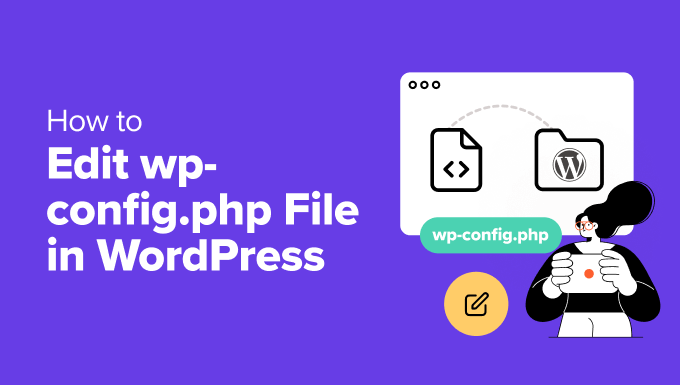
İşte bu kılavuzda ele alacağımız konuların bir listesi:
- What Is the wp-config.php File?
- Create a Backup Before You Edit wp-config.php 💾
- How to Access and Edit the wp-config.php File Safely
- Understanding the wp-config.php File
- MySQL Settings in wp-config.php File
- Authentication Unique Keys and Salts
- WordPress Database Table Prefix
- WordPress Debugging Mode
- Absolute Path Settings
- Useful wp-config.php Hacks and Settings
- Changing MySQL Port and Sockets in WordPress
- Changing WordPress URLs Using wp-config.php File
- Changing Uploads Directory Using The wp-config.php File
- Disable Automatic Updates in WordPress
- Limit Post Revisions in WordPress
- Video Tutorial
- Next Steps to Power Up Your WordPress Skills
wp-config.php Dosyası Nedir?
wp-config.php` dosyası, kendi kendine barındırılan her WordPress sitesinin önemli bir parçasıdır. WordPress’in veritabanınıza bağlanmasına ve sorunsuz çalışmasına yardımcı olan önemli ayarları içerir.
Bu dosya varsayılan WordPress indirmesine dahil değildir. Kurulum işlemi sırasında veritabanı bilgilerinizi girdiğinizde otomatik olarak oluşturulur.
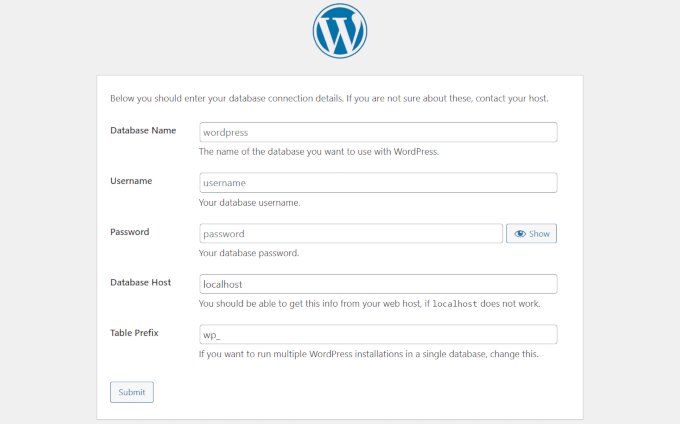
Bu dosyada doğru bilgiler olmadan siteniz veritabanına bağlanamayacaktır. İşte o zaman korkunç “veritabanı bağlantısı kurulurken hata oluştu” mesajını görebilirsiniz.
Veritabanı ayrıntılarının yanı sıra, bu dosya hata ayıklama, güvenlik anahtarları, bellek sınırları ve daha fazlası için ayarları da içerebilir. Bunları makalenin ilerleyen bölümlerinde ele alacağız.
Çoğu kişinin `wp-config.php` dosyasına çok sık dokunması gerekmez. Ancak nasıl çalıştığını ve nasıl güvenli bir şekilde düzenleneceğini bilmek WordPress siteniz üzerinde daha fazla kontrol sahibi olmanızı sağlar.
Eğer buradaysanız, muhtemelen bir değişiklik yapmaya hazırsınız demektir. Bu dosyayı herhangi bir soruna yol açmadan düzenlemenin en güvenli yolunu size göstereceğiz.
💡 S itenizi Bozma Riskini Almak İstediğinizden Emin Değil misiniz?
Kendinizi sıkışmış veya gergin hissediyorsanız, Acil WordPress Desteğimizden yararlanın. Küçük bir ücret karşılığında, WordPress mühendislerimiz web sitenizi ve müşterilerinizi rahatsız etmeden değişiklikleri sizin için uygulayacaktır.
wp-config.php’yi Düzenlemeden Önce Bir Yedek Oluşturun 💾
wp-config.php` dosyası WordPress sitenizin önemli bölümlerini kontrol eder ve bu dosyadaki küçük bir hata bile sitenizi çevrimdışı hale getirebilir.
Bu nedenle, herhangi bir değişiklik yapmadan önce her zaman tam bir WordPress yedeği oluşturmanızı öneririz.
Bir yedekleme içeriğinizi, ayarlarınızı ve dosyalarınızı güvende tutar ve bir şeyler ters giderse her şeyi geri yüklemenizi sağlar.
WordPress’i yedeklemenin en iyi yolu Duplicator kullanmaktır. Bu bizim çözümümüz ve çoğu kullanıcı için en iyi WordPress yedekleme eklentisidir. Sitenizi sadece birkaç tıklamayla yedekleyebilirsiniz.
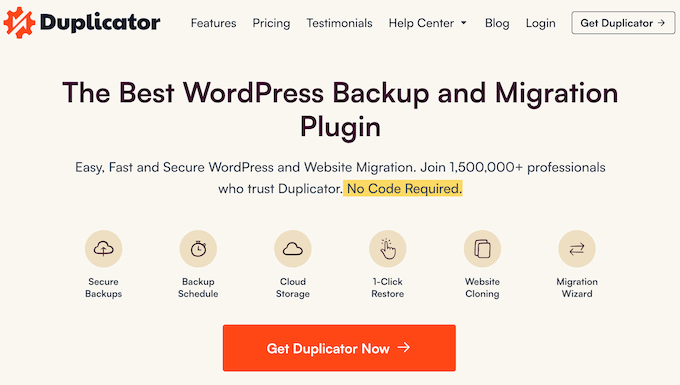
Not: Duplicator’ın ücretsiz bir sürümü de var. Zamanlanmış yedeklemeler ve bulut depolama gibi özellikler için ücretli planı öneriyoruz.
Duplicator’ı Neden Öneriyoruz?
Duplicator’ı tavsiye ediyoruz çünkü WPBeginner da dahil olmak üzere kendi web sitelerimizde yedekleme için kullanıyoruz. Web sitelerimizin güvenliği ve istikrarı için oyunun kurallarını değiştiren bir araç oldu. Daha fazla ayrıntı için Duplicator incelememizin tamamına göz atın.
wp-config.php Dosyasına Güvenle Nasıl Erişilir ve Düzenlenir
wp-config.php` dosyası WordPress barındırma sunucunuzda, sitenizin kök klasöründe bulunur.
Bir FTP istemcisi veya hosting kontrol panelinizdeki Dosya Yöneticisini kullanarak sitenize bağlanarak erişebilirsiniz.
Daha fazla kontrol için genellikle FTP’yi tercih ederiz. Windows’ta FileZilla, WinSCP veya SmartFTP gibi araçlar iyi çalışır. Mac kullanıcıları FileZilla, Transmit veya CyberDuck’ı deneyebilirler.
FTP istemcinizi kullanarak sitenize bağlanarak başlayın. Hosting şirketiniz tarafından sağlanan FTP giriş bilgilerinize ihtiyacınız olacak. Bilmiyorsanız, barındırma şirketinizin destek ekibine sormanız yeterlidir.
Bağlandıktan sonra kök klasörü açın. wp-content, wp-includes ve wp-admin gibi diğer klasörleri göreceksiniz – burası `wp-config.php`nin bulunduğu yerdir.
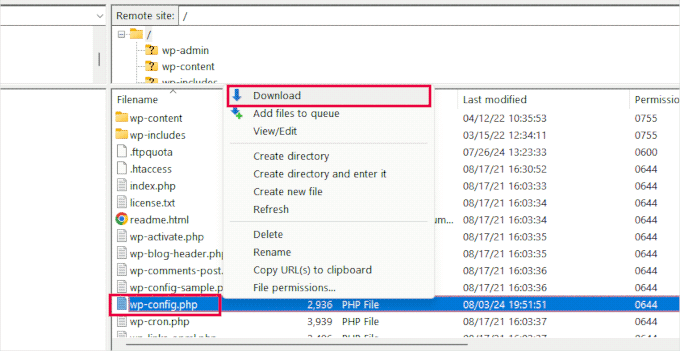
Dosyaya sağ tıklayın ve bilgisayarınıza kaydetmek için ‘İndir’i seçin.
Ardından, Notepad veya TextEdit gibi bir düz metin düzenleyici kullanarak dosyayı açın. Her ikisini de kullandık – basit düzenlemeler için harika çalışıyorlar.
Değişikliklerinizi yaptıktan sonra FTP istemcinize geri dönün ve dosyayı sunucunuzdaki aynı klasöre yükleyin.
FTP istemciniz mevcut dosyanın üzerine yazmak isteyip istemediğinizi soracaktır. ‘Üzerine Yaz’ seçeneğini seçin ve yüklemeyi tamamlamak için Tamam’a tıklayın.
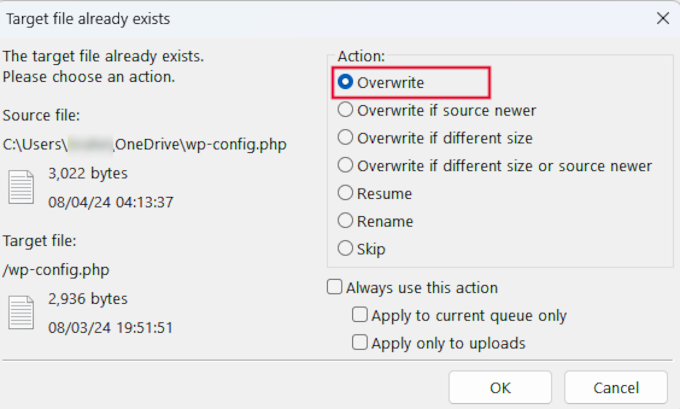
wp-config.php Dosyasını Anlamak
Başlamadan önce, varsayılan wp-config.php dosyasının tam kodunu inceleyelim. Bu dosyanın bir örneğini de burada görebilirsiniz.
1 2 3 4 5 6 7 8 9 10 11 12 13 14 15 16 17 18 19 20 21 22 23 24 25 26 27 28 29 30 31 32 33 34 35 36 37 38 39 40 41 42 43 44 45 46 47 48 49 50 51 52 53 54 55 56 57 58 59 60 61 62 63 64 65 66 67 68 69 70 71 72 73 74 75 76 77 78 79 80 81 82 83 84 85 86 87 88 89 90 91 92 93 94 95 96 | <?php/** * The base configuration for WordPress * * The wp-config.php creation script uses this file during the installation. * You don't have to use the website, you can copy this file to "wp-config.php" * and fill in the values. * * This file contains the following configurations: * * * Database settings * * Secret keys * * Database table prefix * * ABSPATH * * @link https://developer.wordpress.org/advanced-administration/wordpress/wp-config/ * * @package WordPress */// ** Database settings - You can get this info from your web host ** ///** The name of the database for WordPress */define( 'DB_NAME', 'database_name_here' );/** Database username */define( 'DB_USER', 'username_here' );/** Database password */define( 'DB_PASSWORD', 'password_here' );/** Database hostname */define( 'DB_HOST', 'localhost' );/** Database charset to use in creating database tables. */define( 'DB_CHARSET', 'utf8' );/** The database collate type. Don't change this if in doubt. */define( 'DB_COLLATE', '' );/**#@+ * Authentication unique keys and salts. * * Change these to different unique phrases! You can generate these using * the {@link https://api.wordpress.org/secret-key/1.1/salt/ WordPress.org secret-key service}. * * You can change these at any point in time to invalidate all existing cookies. * This will force all users to have to log in again. * * @since 2.6.0 */define( 'AUTH_KEY', 'put your unique phrase here' );define( 'SECURE_AUTH_KEY', 'put your unique phrase here' );define( 'LOGGED_IN_KEY', 'put your unique phrase here' );define( 'NONCE_KEY', 'put your unique phrase here' );define( 'AUTH_SALT', 'put your unique phrase here' );define( 'SECURE_AUTH_SALT', 'put your unique phrase here' );define( 'LOGGED_IN_SALT', 'put your unique phrase here' );define( 'NONCE_SALT', 'put your unique phrase here' );/**#@-*//** * WordPress database table prefix. * * You can have multiple installations in one database if you give each * a unique prefix. Only numbers, letters, and underscores please! */$table_prefix = 'wp_';/** * For developers: WordPress debugging mode. * * Change this to true to enable the display of notices during development. * It is strongly recommended that plugin and theme developers use WP_DEBUG * in their development environments. * * For information on other constants that can be used for debugging, * visit the documentation. * * @link https://developer.wordpress.org/advanced-administration/debug/debug-wordpress/ */define( 'WP_DEBUG', false );/* Add any custom values between this line and the "stop editing" line. *//* That's all, stop editing! Happy publishing. *//** Absolute path to the WordPress directory. */if ( ! defined( 'ABSPATH' ) ) { define( 'ABSPATH', __DIR__ . '/' );}/** Sets up WordPress vars and included files. */require_once ABSPATH . 'wp-settings.php'; |
wp-config.php dosyasının her bölümü dosyanın kendisinde iyi bir şekilde belgelenmiştir. Buradaki neredeyse tüm ayarlar PHP sabitleri kullanılarak tanımlanmıştır.
1 | define( 'constant_name' , 'value'); |
Şimdi wp-config.php dosyasındaki her bir bölüme daha yakından bakalım.
wp-config.php Dosyasında MySQL Ayarları
WordPress veritabanı bağlantı ayarlarınız wp-config.php dosyasının ‘Veritabanı Ayarları’ bölümünde görünür.
Bu bölümü tamamlamak için MySQL ana bilgisayarınıza, veritabanı adınıza, veritabanı kullanıcı adınıza ve parolanıza ihtiyacınız olacaktır.
1 2 3 4 5 6 7 8 9 10 11 12 13 14 15 16 17 18 | // ** Database settings - You can get this info from your web host ** ///** The name of the database for WordPress */define( 'DB_NAME', 'database_name_here' );/** Database username */define( 'DB_USER', 'username_here' );/** Database password */define( 'DB_PASSWORD', 'password_here' );/** Database hostname */define( 'DB_HOST', 'localhost' );/** Database charset to use in creating database tables. */define( 'DB_CHARSET', 'utf8' );/** The database collate type. Don't change this if in doubt. */define( 'DB_COLLATE', '' ); |
İşte bu bölümdeki sabitlerin bir listesi ve ne işe yaradıkları.
| Constant Name | Description |
|---|---|
| DB_NAME | The name of the database for WordPress. |
| DB_USER | The username used to access the WordPress database. |
| DB_PASSWORD | The password for the database username. |
| DB_HOST | The hostname of the database server (usually ‘localhost’). |
| DB_CHARSET | The hostname of the database server (usually ‘localhost’). |
| DB_COLLATE | The collation type for the database (usually left blank). |
Bu değerleri doldurmak için, web hosting hesabınızın kontrol panelinde bulabileceğiniz veritabanı bilgilerine ihtiyacınız olacaktır.
Barındırma sağlayıcınıza bağlı olarak, kontrol paneliniz aşağıdaki ekran görüntülerinden biraz farklı görünebilir. Bu durumda, barındırma hesabınızdaki ‘Veritabanları’ bölümünü aramanız gerekir.
Örneğin, Bluehost kullanıyorsanız, önce hosting hesabınıza giriş yapın. Ardından, web sitenizin altındaki ‘Ayarlar’a tıklayın.
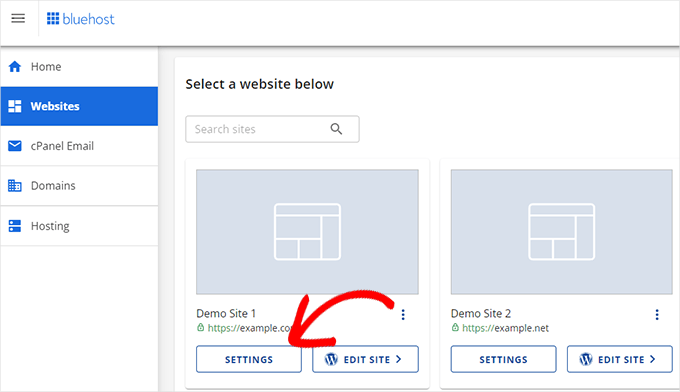
Bu size web siteniz için farklı ayarlar gösterecektir.
Gelişmiş sekmesine geçin ve ardından ‘cPanel’ bölümünün yanındaki ‘Yönet’e tıklayın.
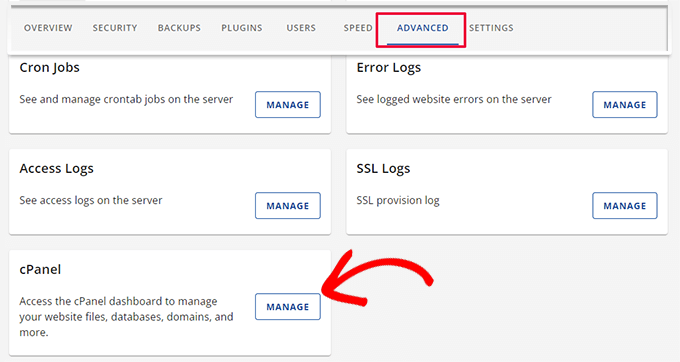
Yeni bir tarayıcı sekmesinde cPanel arayüzünü açacaktır.
Buradan, Veritabanları bölümüne ilerlemeniz ve ‘MySQL Veritabanları’na tıklamanız gerekir.
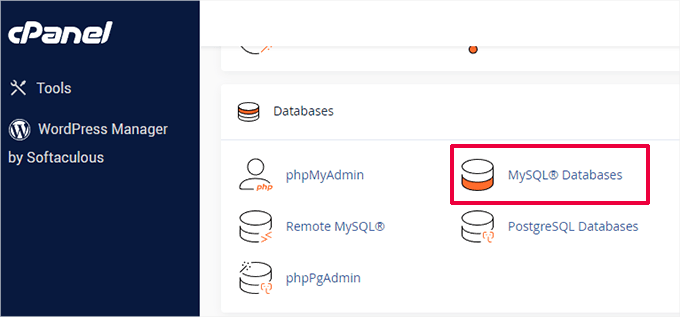
MySQL Veritabanları sayfasında, mevcut veritabanınızın, kullanıcı adınızın ve parolanızın listesini bulacaksınız.
WordPress veritabanınızı veya MySQL kullanıcı adınızı ve şifrenizi bulamıyorsanız, web barındırıcınızla iletişime geçmeniz gerekir.
wp-config.php Dosyasındaki DB_CHARSET ve DB_COLLATE Nedir?
‘DB_CHARSET’ ayarı, WordPress veritabanı tablolarınız için karakter kümesini belirtir. Varsayılan ayar, çoğu dili destekleyen ve geniş uyumluluk sağlayan utf8’dir.
‘DB_COLLATE’ ayarı, veritabanının karakterleri nasıl sıraladığını ve karşılaştırdığını tanımlar.
Boş bırakmanızı ve MySQL’in belirtilen karakter kümesi için varsayılan harmanlamayı kullanmasına izin vermenizi öneririz (utf8 için utf8_general_ci).
Kimlik Doğrulama Benzersiz Anahtarlar ve Tuzlar
Kimlik doğrulama anahtarları ve tuzları wp-config.php dosyasındaki güvenlik özellikleridir. Kullanıcı çerezlerinde saklanan bilgilerin güçlü bir şekilde şifrelenmesini sağlayarak WordPress kurulumunuza ekstra koruma eklerler.
1 2 3 4 5 6 7 8 9 10 11 12 13 14 15 16 17 18 19 20 21 | /**#@+ * Authentication unique keys and salts. * * Change these to different unique phrases! You can generate these using * the {@link https://api.wordpress.org/secret-key/1.1/salt/ WordPress.org secret-key service}. * * You can change these at any point in time to invalidate all existing cookies. * This will force all users to have to log in again. * * @since 2.6.0 */define( 'AUTH_KEY', 'put your unique phrase here' );define( 'SECURE_AUTH_KEY', 'put your unique phrase here' );define( 'LOGGED_IN_KEY', 'put your unique phrase here' );define( 'NONCE_KEY', 'put your unique phrase here' );define( 'AUTH_SALT', 'put your unique phrase here' );define( 'SECURE_AUTH_SALT', 'put your unique phrase here' );define( 'LOGGED_IN_SALT', 'put your unique phrase here' );define( 'NONCE_SALT', 'put your unique phrase here' );/**#@-*/ |
Toplamda sekiz farklı anahtar ve tuz vardır. Her bir anahtar ve tuz çifti, metin numaraları ve özel karakterlerden oluşan rastgele, uzun bir dizidir.
İşte her bir tuşun ne işe yaradığı:
| Constant Name | Description |
|---|---|
| AUTH_KEY | Authenticate cookies and ensure data integrity. |
| SECURE_AUTH_KEY | Secure the authentication cookie when using SSL. |
| LOGGED_IN_KEY | Validate logged-in cookies. |
| NONCE_KEY | Protect nonces (numbers used once) from being guessed. |
| AUTH_SALT | Adds extra security to the authentication process. |
| SECURE_AUTH_SALT | Adds extra security to the authentication process. |
| LOGGED_IN_SALT | Adds extra security to the logged-in process. |
| NONCE_SALT | Adds extra security to the nonce creation and verification process. |
WordPress.org gizli anahtar oluşturucuyu ziyaret ederek yeni anahtarlar oluşturabilirsiniz. Birinin WordPress yönetici alanınıza erişmeye çalıştığından şüpheleniyorsanız, bunları daha sonra da değiştirebilirsiniz.
Daha fazla bilgi için WordPress güvenlik anahtarları hakkındaki kılavuzumuza göz atın.
WordPress Veritabanı Tablo Öneki
WordPress varsayılan olarak veritabanında oluşturduğu tüm tablolara ‘wp_’ önekini ekler.
Kurulum sırasında WordPress veritabanı tablo önekinizi rastgele bir şeyle değiştirmeniz önerilir.
Bu, bilgisayar korsanlarının WordPress tablolarınızı tahmin etmesini zorlaştıracak ve sizi bazı yaygın SQL enjeksiyon saldırılarından kurtaracaktır.
1 2 3 4 5 6 7 | /** * WordPress database table prefix. * * You can have multiple installations in one database if you give each * a unique prefix. Only numbers, letters, and underscores please! */$table_prefix = 'wp_'; |
Önemli ⚠️: Mevcut bir WordPress sitesi için bu değeri değiştiremeyeceğinizi lütfen unutmayın. Mevcut bir WordPress sitesinde bu ayarları değiştirmek için, WordPress veritabanı önekinin nasıl değiştirileceğine ilişkin makalemizdeki talimatları izleyin.
WordPress Hata Ayıklama Modu
Bu ayar özellikle WordPress geliştirmeyi öğrenen veya hataları gideren kullanıcılar için kullanışlıdır.
WordPress varsayılan olarak kod çalıştırırken PHP tarafından oluşturulan bildirimleri gizler. Hata ayıklama modunu ‘true’ olarak ayarlamanız bu bildirimleri size gösterecektir.
Bu, geliştiricilerin hataları bulması için çok önemli bilgiler sağlar. Ayrıca bir WordPress sitesindeki sorunları gidermeye çalışıyorsanız da yardımcı olacaktır.
1 2 3 4 5 6 7 8 9 10 11 12 13 | /** * For developers: WordPress debugging mode. * * Change this to true to enable the display of notices during development. * It is strongly recommended that plugin and theme developers use WP_DEBUG * in their development environments. * * For information on other constants that can be used for debugging, * visit the documentation. * * @link https://developer.wordpress.org/advanced-administration/debug/debug-wordpress/ */define( 'WP_DEBUG', false ); |
Alternatif olarak, hataların ve bildirimlerin bir günlüğünü tutmayı da seçebilirsiniz.
Daha ayrıntılı talimatlar için WordPress’te hata ayıklama modunu etkinleştirme eğitimimize göz atın.
Mutlak Yol Ayarları
wp-config dosyasının son kısmı mutlak yolu tanımlar. Bu talimat WordPress’e çekirdek WordPress dosyalarını nerede bulacağını söyler.
Bu talimattan sonra, wp-settings.php dosyasını yüklemek için ABSPATH kullanılır.
1 2 3 4 5 6 7 | /** Absolute path to the WordPress directory. */if ( ! defined( 'ABSPATH' ) ) { define( 'ABSPATH', __DIR__ . '/' );}/** Sets up WordPress vars and included files. */require_once ABSPATH . 'wp-settings.php'; |
Bu iki ayarın da değiştirilmemesi gerekir.
WordPress ‘in dosyaları nasıl yüklediğini anlamak için WordPress’in perde arkasında nasıl çalıştığına dair açıklamamıza bir göz atın. WordPress çekirdek yazılımının nasıl çalıştığının adım adım bir dökümünü verecektir.
Yararlı wp-config.php Hack’leri ve Ayarları
Şu ana kadar varsayılan wp-config.php ayarlarını ele aldık. Şimdi bazı ek ayarları inceleyelim.
Bu ayarlar isteğe bağlıdır ve gerektiğinde kullanılabilir. Hataları gidermenize ve birçok yaygın WordPress hatasını çözmenize yardımcı olabilirler.
WordPress’te MySQL Bağlantı Noktasını ve Soketlerini Değiştirme
WordPress barındırma sağlayıcınız MySQL ana bilgisayarı için alternatif bağlantı noktaları kullanıyorsa, DB_HOST değerinizi bağlantı noktası numarasını içerecek şekilde değiştirmeniz gerekecektir.
Not: Bu yeni bir satır değildir, ancak mevcut DB_HOST değerini düzenlemeniz gerekir.
1 | define( 'DB_HOST', 'localhost:5067' ); |
Web barındırıcınız tarafından sağlanan bağlantı noktası numarasını 5067 olarak değiştirmeyi unutmayın.
Ana bilgisayarınız MySQL için soket ve boru kullanıyorsa, bu şekilde eklemeniz gerekecektir:
1 | define( 'DB_HOST', 'localhost:/var/run/mysqld/mysqld.sock' ); |
wp-config.php Dosyasını Kullanarak WordPress URL’lerini Değiştirme
Bir WordPress sitesini yeni bir alan adına taşırken WordPress URL’lerini değiştirmeniz gerekebilir.
Bu URL’leri Ayarlar ” Genel sayfasını ziyaret ederek değiştirebilirsiniz.
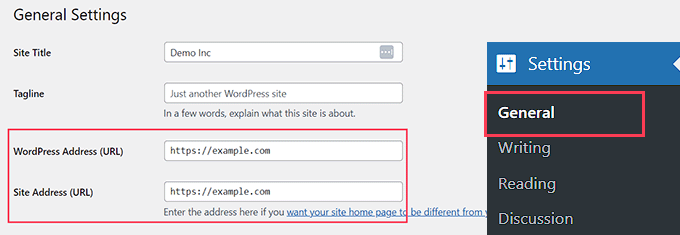
Bu URL’leri wp-config.php dosyasını kullanarak da değiştirebilirsiniz. Bu, çok fazla yönlendirme hatası nedeniyle WordPress yönetici alanına erişemiyorsanız kullanışlı olacaktır.
Bu iki satırı wp-config.php dosyanıza eklemeniz yeterlidir:
1 2 | define('WP_HOME','http://example.com');define('WP_SITEURL','http://example.com'); |
example.com yerine kendi alan adınızı yazmayı unutmayın.
Ayrıca, arama motorlarının www.example.com ve example.com adreslerini iki farklı konum olarak değerlendirdiğini de aklınızda bulundurmanız gerekir (Bkz . www vs non-www – SEO için hangisi daha iyi?).
Siteniz www önekiyle dizine ekleniyorsa, alan adınızı buna göre eklemeniz gerekir.
wp-config.php Dosyasını Kullanarak Yükleme Dizinini Değiştirme
WordPress varsayılan olarak tüm medya yüklemelerinizi/wp-content/uploads/ dizininde saklar.
Medya dosyalarınızı farklı bir konumda saklamak istiyorsanız, wp-config.php dosyanıza bu kod satırını ekleyebilirsiniz:
1 | define( 'UPLOADS', 'wp-content/media' ); |
Yükleme dizini yolunun WordPress’te otomatik olarak ayarlanan ABSPATH’e göre göreceli olduğunu unutmayın. Buraya mutlak bir yol eklemek işe yaramayacaktır.
Daha fazla bilgi için WordPress’te varsayılan medya yükleme konumunun nasıl değiştirileceğine ilişkin ayrıntılı kılavuzumuza bakın.
WordPress’te Otomatik Güncellemeleri Devre Dışı Bırakma
WordPress varsayılan olarak otomatik güncellemeleri etkinleştirmiştir. Bu, WordPress sitelerinin küçük bir güncelleme mevcut olduğunda otomatik olarak güncellenmesini sağlar.
Örneğin, siteniz WordPress 6.6 çalıştırıyorsa ve 6.6.1 güvenlik güncellemesi yayınlandıysa, WordPress güncellemeyi otomatik olarak yükleyecektir.
Ancak WordPress 6.7 yayınlandığında güncellemeyi başlatmanız istenecektir.
Otomatik güncellemeler güvenlik açısından kritik öneme sahip olsa da, birçok kullanıcı bunların web sitelerini bozarak erişilemez hale getirebileceğinden korkuyor.
Bu tek satırlık kodu wp-config.php dosyanıza eklemek WordPress sitenizdeki tüm otomatik güncellemeleri devre dışı bırakacaktır:
1 | define( 'WP_AUTO_UPDATE_CORE', false ); |
Daha fazla bilgi için WordPress’te otomatik güncellemelerin nasıl devre dışı bırakılacağına ilişkin eğitimimize bakın.
WordPress’te Yazı Revizyonlarını Sınırlama
WordPress yerleşik otomatik kaydetme ve revizyonlarla birlikte gelir. WordPress’te yazı revizyonları ile değişikliklerin nasıl geri alınacağı hakkındaki eğitimimize bakın.
Revizyonlar çoğu web sitesinde çok az yer kaplar. Ancak, bazı büyük web sitelerimiz için veritabanı yedekleme boyutunda önemli bir artış olduğunu fark ettik.
Büyük bir web sitesi işletiyorsanız, veritabanında tutmak istediğiniz revizyon sayısını sınırlayabilirsiniz.
Bir gönderi için saklanan revizyon sayısını sınırlamak için bu kod satırını wp-config.php dosyanıza eklemeniz yeterlidir:
1 | define( 'WP_POST_REVISIONS', 3 ); |
3 yerine saklamak istediğiniz revizyon sayısını yazın.
WordPress artık eski revizyonları otomatik olarak atacaktır. Ancak, eski yazı revizyonlarınız hala veritabanınızda saklanır. WordPress’te eski yazı revizyonlarının nasıl silineceğine ilişkin eğitimimize bakın.
Video Eğitimi
Ayrıca daha görsel bir kılavuz görmek isterseniz, aşağıdaki YouTube eğitimimize göz atın:
WordPress Becerilerinizi Güçlendirmek için Sonraki Adımlar
Artık `wp-config.php` dosyasını nasıl düzenleyeceğinizi bildiğinize göre, sitenizi daha da iyi hale getirmek için başka neleri değiştirebileceğinizi merak ediyor olabilirsiniz. Keşfetmeye devam etmenize ve becerilerinizi geliştirmenize yardımcı olmak için favori eğitimlerimizden birkaçını bir araya getirdik.
Her biri WordPress sitelerini yönetirken kendi kullandığımız pratik ipuçlarını içeriyor:
- WP-Config’de WordPress Hata Günlükleri Nasıl Ayarlanır?
- En Çok Aranan WordPress İpuçları, Püf Noktaları ve Hack’leri
- WordPress için En Yararlı .htaccess Püf Noktaları
- En Yararlı Zaman Kazandıran WordPress Klavye Kısayolları
Bu makalenin WordPress’te wp-config.php dosyasını nasıl düzenleyeceğinizi ve onunla yapabileceğiniz tüm harika şeyleri öğrenmenize yardımcı olduğunu umuyoruz. WordPress yönetici dizinini parola ile koruma hakkındaki makalemizi veya WordPress yönetici çubuğunu kullanma ipuçlarımızı da görmek isteyebilirsiniz.
If you liked this article, then please subscribe to our YouTube Channel for WordPress video tutorials. You can also find us on Twitter and Facebook.





Sean Hodge
I believe you should not put any custom rules below the ABSPATH / vars bit down at the bottom, but can you put stuff in any order above those lines?
I’ve got some time on my hands, so I’ve been doing just that, moving stuff around the wp-config file, and removing all the extra fluff between comments. I now know what it all does, and have just left a simple title above each group of rules, such as
/**
* Authentication Unique Keys and Salts.
*/
All the rest of the info about Salts, and debugging etc, is now gone, the stuff that usually appears in green.
What I also did was move the $table_prefix above the Salts, right under the rest of the database info.
I’ve done this all because when I do go in there to modify actual rules, I have to wade my way through what is now useless info, to me.
So far, nothing has exploded, but I thought to ask anyway.
WPBeginner Support
You can change the order of the other content in that file if you wanted, we would warn to be careful when moving that you don’t remove part of the code and normally you should not need to edit your wp-config file.
Admin
Priyanshu Nandi
Which code lines l have to type to increase
Max_input_vars value in this file
WPBeginner Support
That would require changes to your htaccess or a different file, we would recommend reaching out to your host for assistance with what you’re wanting to do.
Admin
WPBeginner Support
Thank you, glad you liked our article
Admin
S.s. Brar
Great article. A must have information for WP admins.
Thanks to Syed and His Team.
WPBeginner Support
Glad our article could be helpful
Admin
Mister No
Hi there, great article. I’m having a problem with my website mobile version. When I try to open it on the mobile phone it says “This site is experiencing technical difficulties”.
What should I do to make my site work again properly?
Thanks in advance
WPBeginner Support
There are a few possible reasons you could be receiving that error, for a starting point you would want to take a look at our guide here: https://www.wpbeginner.com/beginners-guide/beginners-guide-to-troubleshooting-wordpress-errors-step-by-step/
Admin
Paul
Syed, all of a sudden, I can’t upload images (message: missing a temporary folder). Tried to log into WordPress to check support blogs and my username is not recognised.
WPBeginner Support
For that error, you would want to take a look at our guide here: https://www.wpbeginner.com/wp-tutorials/how-to-fix-missing-a-temporary-folder-error-in-wordpress/
Admin
Gale
I am a newbie at wordpress. I uploaded the files via Filezilla and got everything configured. Now how exactly do I actually access my new wp-blog site?
Wp is in the root (public_html) of my website. There were several other file folders that came with Wp. Do I upload them into the public_html folder as well?
WPBeginner Support
If you’re installing WordPress using FTP then you would want to take a look at our guide here:
https://www.wpbeginner.com/how-to-install-wordpress/#installftp
Once the site is set up you would want to go to your login page and log in with the user you created in the installation process:
https://www.wpbeginner.com/beginners-guide/how-to-find-your-wordpress-login-url/
Admin
Esther
Hi, I found out when I was installing WordPress, it was installed in subdirectory Wp and has a result my website can’t go live, my web host said I have to uninstall and install again and I should leave the Wp in the Installation panel blank, my problem is that I have designed the website only to go live and once I uninstall everything will be wiped off, what do I about it, Is there a way to avoid that?
WPBeginner Support
If your host requires the site to be in the main directory, you would want to follow the steps in the WordPress coded to move directories on your existing server
Admin
Mina
Hi,
Thank you for the useful article.
I’m new to this file and I have a basic question. I changed the cache plugin of my site and I need to change the line about it at the beginning of the file to override details of the previous plugin.
Once my file is updated, can I upload it while the cache plugin is activated, and deactivate/reactivate it just after, or do I have to deactivate the plugin before uploading the new wp-config file ?
Thanks for your help.
WPBeginner Support
If your plugin is requiring you to edit your wp-config file you would normally want to edit the wp-config file before activating your new plugin.
Admin
Tiar
hi, i have a wordpress site, i want edit my wordpress site in local, but when i already backup and run my wordpress in local. the page is full of white. can you help me ? im beginner in wordpress
WPBeginner Support
For moving your live site to a local installation, you would want to use the guide here: https://www.wpbeginner.com/wp-tutorials/how-to-move-live-wordpress-site-to-local-server/
Admin
Arthur
I have updated my website (lostkatanning.com) o WP 5.1 (the Gutenberg update) but now, when working on pages or posts it has slowed right down to a crawl and takes forever to respond to even a single key touch. I have tried numerous things from various websites but nothing seems to work. It is starting to do my head in! Any ideas on how to get my speed back?
WPBeginner Support
Hi Arthur,
You can disable the Gutenberg by installing the classic editor plugin to temporarily solve the problem.
Admin
mostafa
Hi
I have a wordpress site. Today I realized my wp-config.php file has been removed for no reason (The reason is not important for me right now).
I want to know what happens if I create another wp-config.php file in the root directory of my website by renaming the wp-config-sample.php file again and set the database name blah blah blah
does it affect my pages and posts? How about the users who have signed up to my website? does it remove them? If the answer is yes, isn’t it better for me to restore backup? The only problem for restoring backup is that it is for two days ago and I posted a new content yesterday and I will miss it.
Thank you very much in advance
WPBeginner Support
Your user and post information is in the database so that information shouldn’t be affected, as long as you connect it to your correct database then there shouldn’t be any change.
Admin
Deepak
Hello,
How do I edit wp-config for setting other smtp using WP smtp plugin ?
Plugin says, “The password is stored in plain text. We highly recommend you setup your password in your WordPress configuration file for improved security; to do this add the lines below to your wp-config.phpfile.
define( ‘WPMS_ON’, true ); define( ‘WPMS_SMTP_PASS’, ‘your_password’ ); ”
Where do I exactly add the code ? It don’t shown in tutorial video or article of Wpbeginner.
WPBeginner Support
Hi Deepak,
You can add this code just before the line that says ‘That’s all, stop editing! Happy blogging’ in your wp-config.php file.
Admin
Riyaz
Thank you for sharing this article, it was simple and easy to understand.
Gaurav Bhatnagar
Hi, I just updated my WordPress to new version manually using FileZilla. My website was working. But then, I did some update inside wp-config.php file. Now the size of that file on server has become ‘0’. Even if I update it from local PC, it still remains ‘0’. What should I do? Now website is not working. I am getting – HTTP Error 500
WPBeginner Support
Hi Gaurav,
You can download a fresh copy of WordPress and extract it on your computer. Inside it you will find a wp-config-sample.php file. You can upload this file to your server and rename it to wp-config.php. You will now need to edit wp-config.php file and enter your WordPress database information.
Admin
Gaurav Bhatnagar
It worked. Thank you.
Greg Bryant
I have an intranet-based wordpress site that I’m setting up. I’m having issues with the proxy configuration in wp-config.php. I’ve tried about everything I know and I still keep getting ‘Proxy Authentication Required” errors.
define(‘WP_PROXY_HOST’, ‘https://proxy.domain.com’);
define(‘WP_PROXY_PORT’, ‘3128’);
define(‘WP_PROXY_USERNAME’, ‘domain\\username’);
define(‘WP_PROXY_PASSWORD’, ‘xxxxxx’);
define(‘WP_PROXY_BYPASS_HOSTS’, ‘localhost’);
Our internal wordpress site can detect that there are new versions of plug-ins but when I try to update I get the proxy authentication error. I’ve tried the variables above with https, http, just proxy.domain.com, the username escaping the \, not escaping the backslash, etc. I looked at the code in class-wp-http-proxy.php and it appears the authentication connects the username with a : and then the password like the http(s)_proxy environment variable. I’ve tried local host for the bypass and an empty string. Our Windows domain uses an file; is there a place to specify this?
I get the same proxy authentication errors trying to download anything from the internal wordpress site.
Error occurred. Something may be wrong with WordPress.org or this server’s configuration. If you continue to have problems, please try the support forums. (WordPress could not establish a secure connection to WordPress.org. Please contact your server administrator.) in /var/www/epkb.mw-process-ctrl.com/public_html/wp-admin/includes/plugin-install.php on line 168
I’m also having an issue with php’s file_get_contents if that’s something wordpress uses. cURL works fine.
Any ideas?
Thanks
WPBeginner Support
Hi Greg,
Please make sure that your localhost environment has curl extension installed and enabled for PHP. Please see our guide on how to fix secure connection error in WordPress for more details.
Admin
Greg Bryant
I have curl installed.
It lists ipV6 as yes but I have ipV6 disabled since our network doesn’t support it.
I think the problem is authenticating with our proxy. On the server I use:
(the \ is escaped when setting the env variables). Above is my wp-content proxy settings.
I’m using ufw for my firewall and have tried with it enabled & disabled with the same results.
Any other ideas?
Thanks
WPBeginner Support
Hi Greg,
We are not sure. You can post on WordPress.org forums may be someone who has faced similar situation can help out.
Jon M
Do the changes take effect immediately after saving the new wp-config file?
WPBeginner Support
Hey Jon,
Yes, they are effectively immediately. However, if you are editing wp-config file in a text editor on your computer, then simply saving your changes may not change the wp-config.php file on your server. You will need to upload the changed wp-config.php file back to your server for changes to take effect.
Admin
Andy
What’s the best way to upload the changed wp-config.php file back to the server?
Can the tutorial be updated with how to upload the adjusted config file? The tutorial seems to be incomplete for the (relative) novice
WPBeginner Support
Hi Andy,
We have linked to our article on how to use FTP to upload WordPress files. It also applies to editing your wp-config.php file. You can simply download your wp-config.php file to your computer using FTP. Edit it to make your desired changes and then upload it back using the same FTP client.
Hope this helps.
ayush
I did something silly , i removed the www part from wp site url under Setting-General . Now admin panel is getting redirected to wordpress one. i used your steps to copy both lines with modification and uploaded via ftp . No luck .Plz help
Boris
Excellent post. I am a newbie and learned a lot.
I have an issue with my site. It looks like I have been hacked. I ran WordFence scan and it caught a line of code in my wp-config.php file that it flagged as not belonging there. Following is the code:
My question is this. Can I remove the "@include…" from the file without screwing up the .php file.
Any guidance will be appreciated.
WPBeginner Support
Hi Boris,
Is the file part of the core WordPress software, a plugin, or a theme? If yes, then download a fresh copy of WordPress core, plugins, or theme the file belongs to and then upload the new file.
You can also download the file to your computer before editing the code as a backup. If anything goes wrong you can then upload it back.
Admin
Saud Razzak
Great post, glad I read.
Steph
I’m having problems accessing site. I debugged and am getting a list of problems but most seem to come back to this one:
“Notice: get_settings is deprecated since version 2.1.0!
Use get_option() instead. in /usr/local/pem/vhosts/xxxxxx/webspace/siteapps/WordPress-xxxxx/htdocs/wp-includes/functions.php on line 3752″
But line 3752 reads:
” trigger_error( sprintf( __(‘%1$s is deprecated since version %2$s! Use %3$s instead.’), $function, $version, $replacement ) ); ”
So i’ve no idea what to replace. I’m sure this is 101 stuff to you, but I’m really confused!! I would really appreciate your advice, thank you.
Steph
Found your section on disabling plugins – which was a great help as the the site is now viewable whilst I try to resolve. This is the message I see now when logged in WP Admin
” Catchable fatal error: Argument 1 passed to Genesis_Admin_CPT_Archive_Settings::__construct() must be an instance of stdClass, instance of WP_Post_Type given, called in /usr/local/pem/vhosts/xxxxxx/webspace/siteapps/WordPress-xxxxxx/htdocs/wp-content/themes/genesis/lib/admin/menu.php on line 122 and defined in /usr/local/pem/vhosts/xxxxxx/webspace/siteapps/WordPress-xxxxxx/htdocs/wp-content/themes/genesis/lib/admin/cpt-archive-settings.php on line 38 ”
Am in a spot of bother and could really use your help – thank you!
WPBeginner Support
Hey Steph,
Try updating your Genesis child theme. Connect to your website using FTP and download your child theme as a backup. After that delete child theme folder from your website.
Next, download a fresh copy of the theme and install it. If this doesn’t work, then try updating Genesis core itself.
Admin
Hell Men
If i delete salt key can i decrypt wordpress password ?
Sean
Hi,
I did something silly and now can’t get my site to work. Basically I kept my site live at said URL example.com and created a folder where I built the WordPress site example.com/Wordpress. However when I went to put the wordpress site into the root folder after backing everything up I forgot to change the site URL in the dashboard. i basically then removed my entire site and copied everything from the wordpress site into the root URL. It didn’t work – so I thought I would remove everything and restore my site as it was with both the wordpress and the normal site working.
However once I restored all the files the wordpress site now errors with 404 Page not found and I can’t login into the dashboard either.
Any idea how I can restore this? I think it is looking in the root directory and WordPress folder for the site or something similar and it’s causing the error – but how do I fix it?
Thanks
Sean
WPBeginner Support
Hi Sean,
You can update WordPress URLs by adding this code to your wp-config.php file:
define('WP_HOME','http://example.com');define('WP_SITEURL','http://example.com');
Admin
Dan
Hello i would like to have it when i upload an image it gets uploaded to my cloud from wordpress.
i got a url & api key.
Any suggestions would be cool. thanks.
Eeswar Reddy
Best site for WordPress Beginners. Solved my blog problem simply. Thank u so much Sir…
WPBeginner Support
You are welcome Don’t forget to join us on Twitter for more WordPress tips and tutorials.
Don’t forget to join us on Twitter for more WordPress tips and tutorials.
Admin
Karl
Nice instructions, as far as they go. However, I know it is ALSO possible to edit wp-config.php directly through WordPress’ Admin area but it seems to be a closely guarded secret as to HOW to actually do this. I do not have FTP access to my site so I have to use some other method and I’d rather not go chasing down the rabbit hole of trying out various flaky plugins until I find one that actually works. Your assistance as to what menu drill-down to explore in WordPress Admin would be greatly appreciated.
WPBeginner Support
It is not a good idea to edit wp-config.php file inside WordPress admin area. One tiny mistake and you will be locked out of your WordPress site. If you do not have FTP access, you can try editing it via cPanel’s file manager.
Admin
Angela
I don’t want to sound stupid, but please help me understand… are the wp-config.php changes supposed to be made on my Mac or on the host for my website. They are two different machines.
Please help! I keep making changes to my web site and all of a sudden they just do not ‘take’.
Best regards,
Angela
WPBeginner Support
You can make changes to wp-config.php file using an FTP client. It allows you to edit files on your web server. After connecting to your website using an FTP client, you need to locate wp-config.php file and download it to your computer. Make changes it to it using a text editor like TextEdit. Save your changes and then upload the file back to your web server using the FTP client.
Admin
Sharron
Ok, so I added define(‘WP_ALLOW_REPAIR’, true); to my downloaded wp config file with notepad. Now what?
Ray
Once you have done that, you can see the settings by visiting this URL on your blog:
yoursite.com/wp-admin/maint/repair.php
You have 2 buttons
1st – Repair Database
2nd – Repair and Optimize Database
I suggest u click the 1st one and wait for the process to finish.
John Johnson
CODA is an FTP Client as well. Correct?
PiNo
Hi,
For security I add to my .htaccess
<files wp-config.php>
order allow,deny
deny from all
</files>
Kind regards